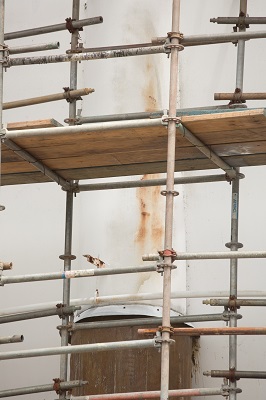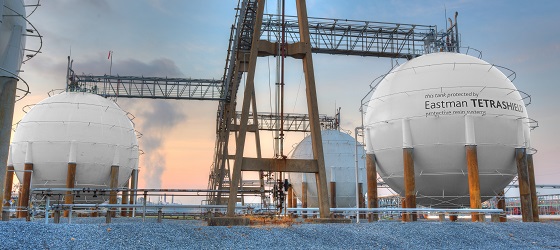Founded in 1920, Kingsport, Tenn.-based Eastman Chemical is one of the nation’s leading manufacturers of specialty chemicals, which it produces for a wide variety of end uses and markets. With a century of operating experience, Eastman has learned that having a dependable contractor for their plants is critical — especially given their vast scope of operations and the need for regular maintenance in chemical-laden environments.
For more than 30 years, Eastman’s alliance contractor in Kingsport has been Partner Industrial. “We’ve had a maintenance painting program here since 1989,” said Keith Barger, operations manager. “We’re a civil services provider, built from the ground up.” While Partner averages between 60 and 110 workers within its coatings division, depending on seasonality, the company has ~1,300 employees overall with segments including packaging, warehousing, janitorial servicing, insulation, asbestos abatement, industrial coatings, and general services.
That close relationship helped pave the way to one of Eastman’s latest projects with Partner, which occurred when a carbon steel sphere at 50 feet (15.2 m) in diameter was blasted and painted in late 2017. Based on the sphere’s location at the forefront of the Kingsport complex, this was far from a run-of-the-mill job.
“The sphere is located close to a public highway and was coated in lead-containing paint,” said Gary Whittaker, Eastman’s lead technical consultant for the project. “The substrate was in good condition, but the existing coating was in poor condition and contained lead. It needed to be removed.”
Complete Containment
The methanol-containing tank was also located within a very active chemical complex. Given all those factors, full containment was a must — and the diversity of Partner’s expertise as a services provider and its knowledge of the 8,000-square-foot (743.2 m2) jobsite paid immediate dividends. “We built the scaffolding ourselves,” Barger said. “We fully contained it.”
A complete scaffold was erected to encapsulate the sphere for both blasting and painting, with vapor blast equipment used to reduce dust and the amount of abrasive consumed. “The primary concern was lead containment, and complete encapsulation mitigated this risk,” Whittaker said. “All laws regarding lead abatement were closely followed.”
The scaffold framing was covered with 10 Eagle Industries screen tarps of 50 feet by 100 feet (15.2 x 30.5 m) in size. Given the tank’s location next to the road, the crew needed to prioritize both aesthetics and protection of the surrounding areas.
While the Partner crew averaged about eight workers for the project’s application phases, the complexities of scaffolding and full containment demanded more manpower. “There were probably about 15 to 20 people with the scaffolding,” Barger said. “You’ve got a lot of men on the ground, all trying to make it go up all the same time.”
Blasting Off
 Once containment was in place, first on the agenda was surface preparation. Working section by section, the crew’s objective was to blast the carbon steel to achieve the NACE No. 2/Society for Protective Coatings (SSPC) Surface Preparation (SP) 10, “Near-White Metal Blast Cleaning” standard.
Once containment was in place, first on the agenda was surface preparation. Working section by section, the crew’s objective was to blast the carbon steel to achieve the NACE No. 2/Society for Protective Coatings (SSPC) Surface Preparation (SP) 10, “Near-White Metal Blast Cleaning” standard.
Personal protective equipment (PPE) gear for crew members included complete Tyvek suits with forced air half-mask respirators and high-efficiency particulate air (HEPA) filters, along with harnesses secured to the scaffold structure. “The primary safety concerns were lead exposure, paint fume exposure during spraying operations, and fall protection,” Whittaker said.
As part of the blasting process, the crew began by spraying the Enviro-Prep chemical stripper at an average of 20 mils (508.0 microns) wet film thickness (WFT). They did this utilizing a Graco Extreme 70:1 airless sprayer with a 519 spray tip. “This enabled the spent blast media containing lead to be disposed of as non-hazardous waste in a landfill after blasting,” Barger explained.
Then, using a Graco EcoQuip2 vapor blaster with a #8 performance nozzle and 30/60 garnet, they blasted all coated surfaces to achieve a 2.5–3.5 mil (63.5–88.9 microns) profile. The HoldTight 102 cleaner/rust inhibitor was used to prevent any flash rusting and to clean any containments from the blasted substrate.
The crew powered its various pieces of blast equipment with two 900 CFM (25.5 m3/min.) compressors, and blast media was cleaned up via a vacuum truck. Testex tape was used to check the blast profile, while a psychrometer helped the crew check for ambient conditions, such as relative humidity.
Coating Collaboration
Another unique aspect of this project was the client’s technical involvement in the new coating system. The selected system for the methanol sphere was the VSC 1100 epoxy mastic aluminum primer from Valentus Specialty Chemicals, followed by the VSC 1200 urethane — which includes Eastman’s own Tetrashield protective resin for heavy-duty protection.
“It’s an aliphatic urethane,” Barger said of the system. “That’s long been the topcoat of choice when it comes to chemical resistance. In this case, Eastman was also involved in the development of this topcoat. They did a lot of on-site testing.”
All welds were initially stripe coated with the VSC 1100 primer at 7–9 mils (177.8–228.6 microns) WFT, followed by a spray application of a full coat of the same thickness using the Graco Extreme 70:1 airless machine at the same approximate thickness. A similar process was utilized for the VSC 1200 urethane topcoat, which began when the crew stripe coated all welds at 4–6 mils (101.6–152.4 microns) WFT via a brush-and-roll method. Then, the full coat was sprayed on at a similar thickness — again utilizing the Graco airless sprayer.
Each layer of the primer and topcoat dried to between 5 and 7 mils (127.0 and 177.8 microns) and 3 and 4 mils (76.2 and 101.6 microns) dry film thickness (DFT), as checked by Type 1 and Type 2 gages. “Everything went smoothly,” Barger said of the application. “A lot of these folks working in our coatings department have worked here for many years. They work hand in hand to get the project complete.”

Rave Reviews
Ultimately, the industrial project in Kingsport was completed within about six weeks in late 2017. “Everything went as scheduled,” Barger said. “What we heard [from the client] was very positive.”
Eastman didn’t just state its approval, though. They showed it by enlisting Partner to perform similar work on other carbon steel spheres at the site. As of early 2020, Partner crews had coated two other similarly-sized chemical tanks at the Kingsport site, and a fourth is scheduled.
“We’ve done three of the four so far, and we still have one more to do,” Barger said. “It’s a partnership, and we work side by side.” Working in close collaboration with both the coating manufacturer and contractor, the 100-year-old chemical company enters its latest decade with customized solutions for corrosion protection.